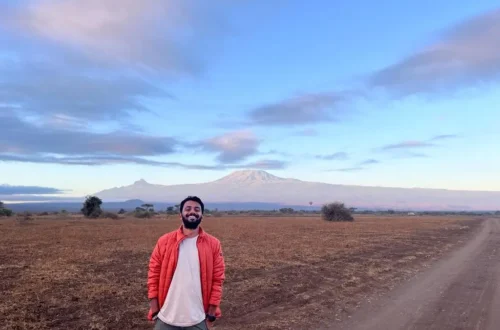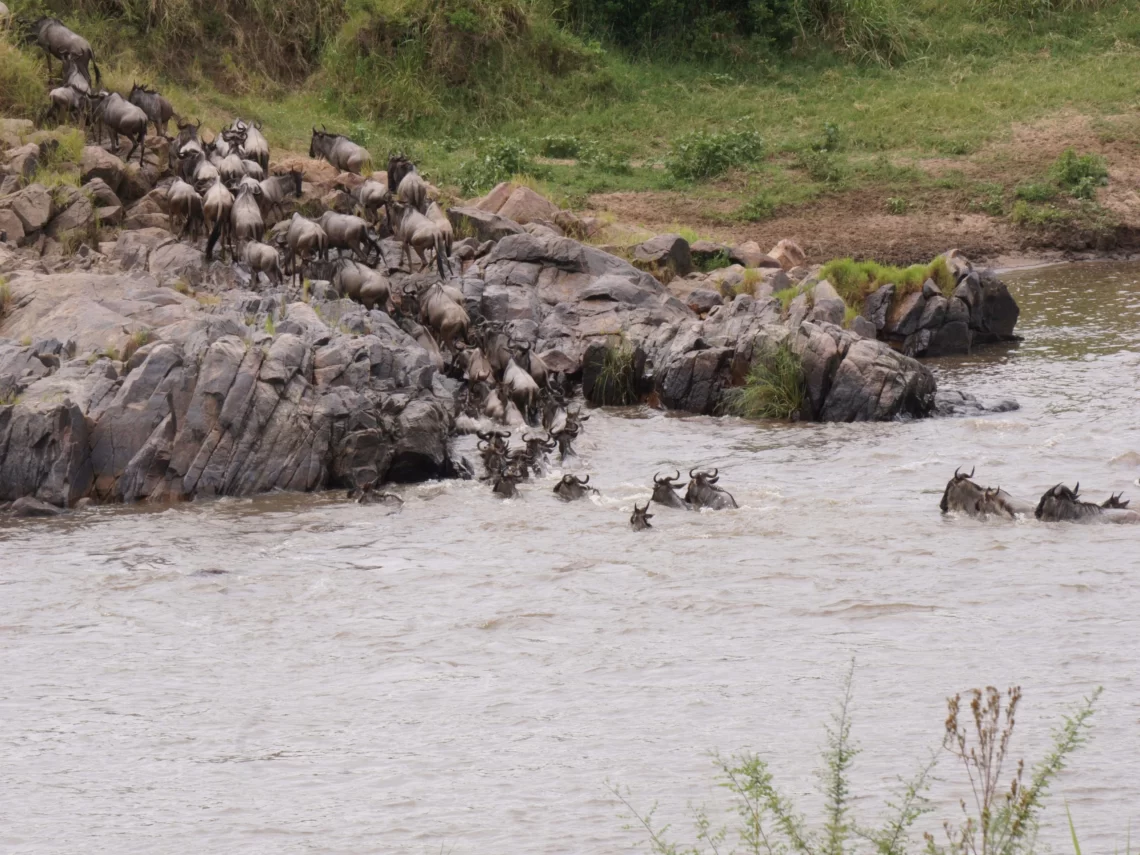
5-Days Wildebeest Migration Safari in Tanzania on Budget
The Great Wildebeest Migration is one of the biggest wildlife events one can experience. Since my childhood, I grew up watching the wildebeest migration documentaries on Nat Geo. And finally, in 2023 I was able to fulfil my dream. I’m sure a lot of you guys have the wildebeest migration on top of your bucket list and want to plan a trip to Tanzania to experience it.
The savannahs of Tanzania are no different from the Lion King movie, which makes the Tanzania Safari an unforgettable experience.
This guide will explain the best season to experience the wildebeest migration, how many days are needed for this phenomenon, and how to plan your Tanzania safari on a budget.
I share my 5-day experience of the migration safari. Stay tuned until the end to learn about the migration safari because there’s a lot more to experience than any documentary you’ve seen.
What month is the best to see the wildebeest migration?
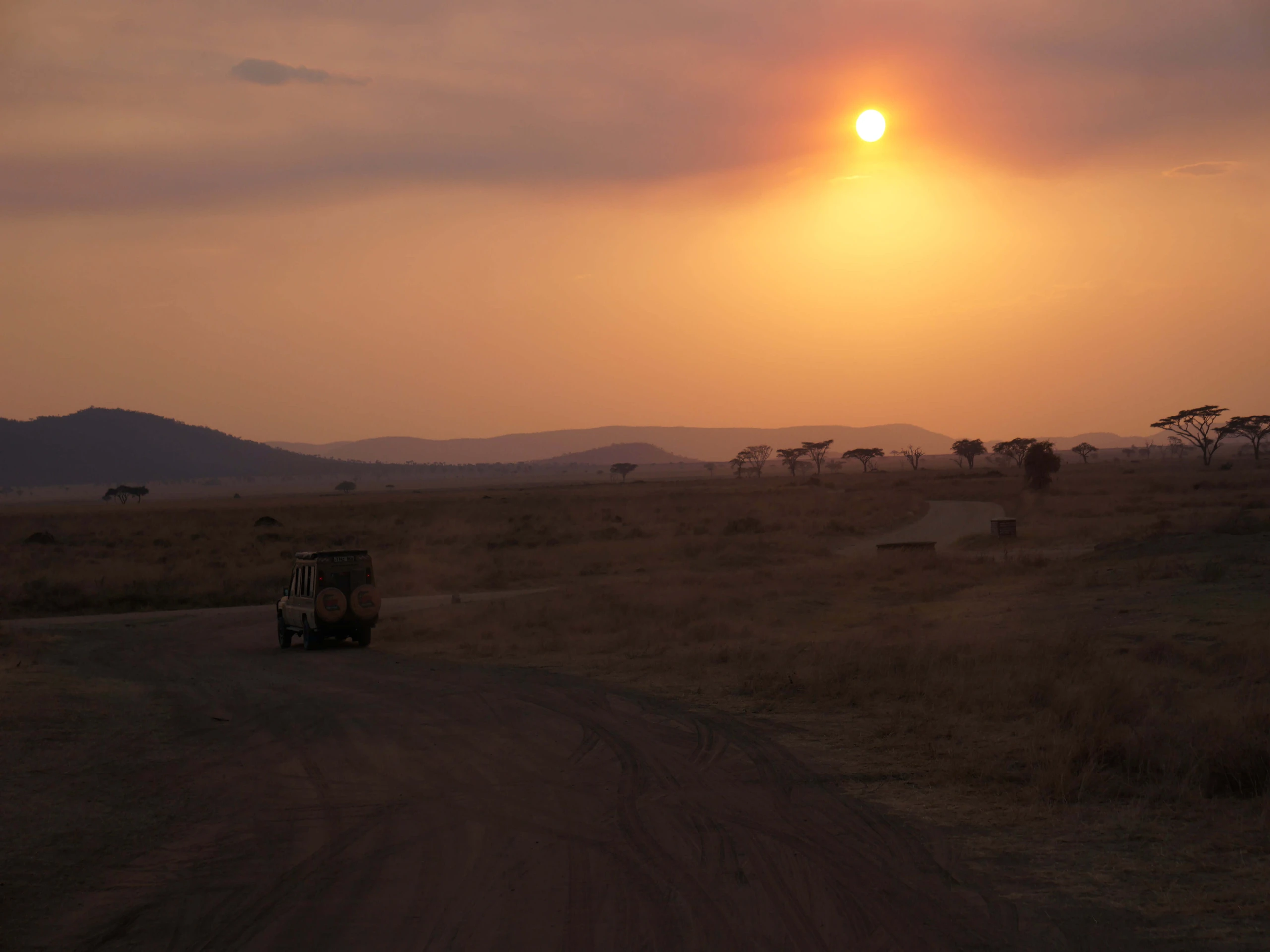
The best months to see the wildebeest migration is from June to September. But If I had to point out the best 1-month window, it would be from mid-July to mid-August. During this time millions of wildebeest and zebras make their way from Serengeti in Tanzania to Masai Mara in Kenya in search of greener pastures.
The most amazing sight of the complete wildebeest migration is when they cross the Mara River which is filled with crocodiles. This can be experienced both in Tanzania and Kenya.
How many days is enough to experience the Tanzania wildebeest safari?
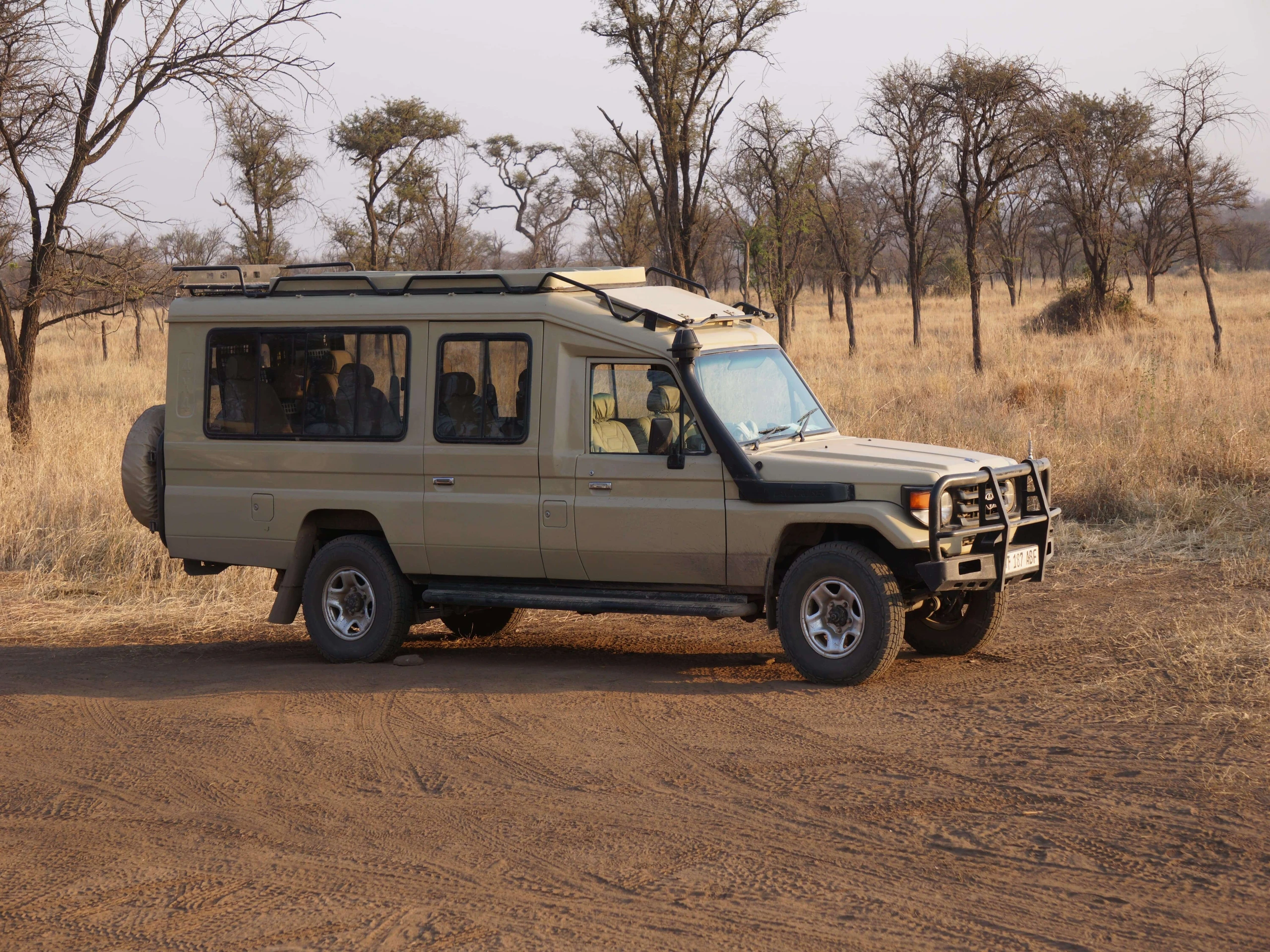
It is generally recommended to spend 3-4 days in Serengeti, out of which 2 days to be at least in northern Serengeti where the wildebeest migration takes place. You can also add one day each to Ngorongoro Crater and Tarangire National Park to have a complete Tanzania safari experience.
I will now be sharing my 5-Day Tanzania safari experience where I spent 3 days in Serengeti National Park and one day each in Tarangire National Park and Ngorongoro Crater, or at least this was the planned itinerary.
Beginning of my Tanzania Safari
After spending more than a week in Zanzibar, it was time to head to the most exciting adventure that I had planned for this trip, the wildebeest migration safari. The safari starts from Arusha. I was picked up by the company at 6 am and we then headed to the company office to pick up other people who would be joining the group.
As soon as we picked the first two people, we headed towards Mto Wa Mbu where we would be transferred in the safari jeep. As soon as you are on the outskirts of Arusha you can immediately see the landscape change. After reaching Mto Wa Mbu, I had my breakfast and sat in the jeep, to my surprise I was the only one and the other two people were shifted to a different jeep.
I was later told there would only be two more people joining me in the jeep which had a capacity of seven people. I thought that was great as this group safari was turning more or less into a private safari.
Entering the Ngorongoro National Park
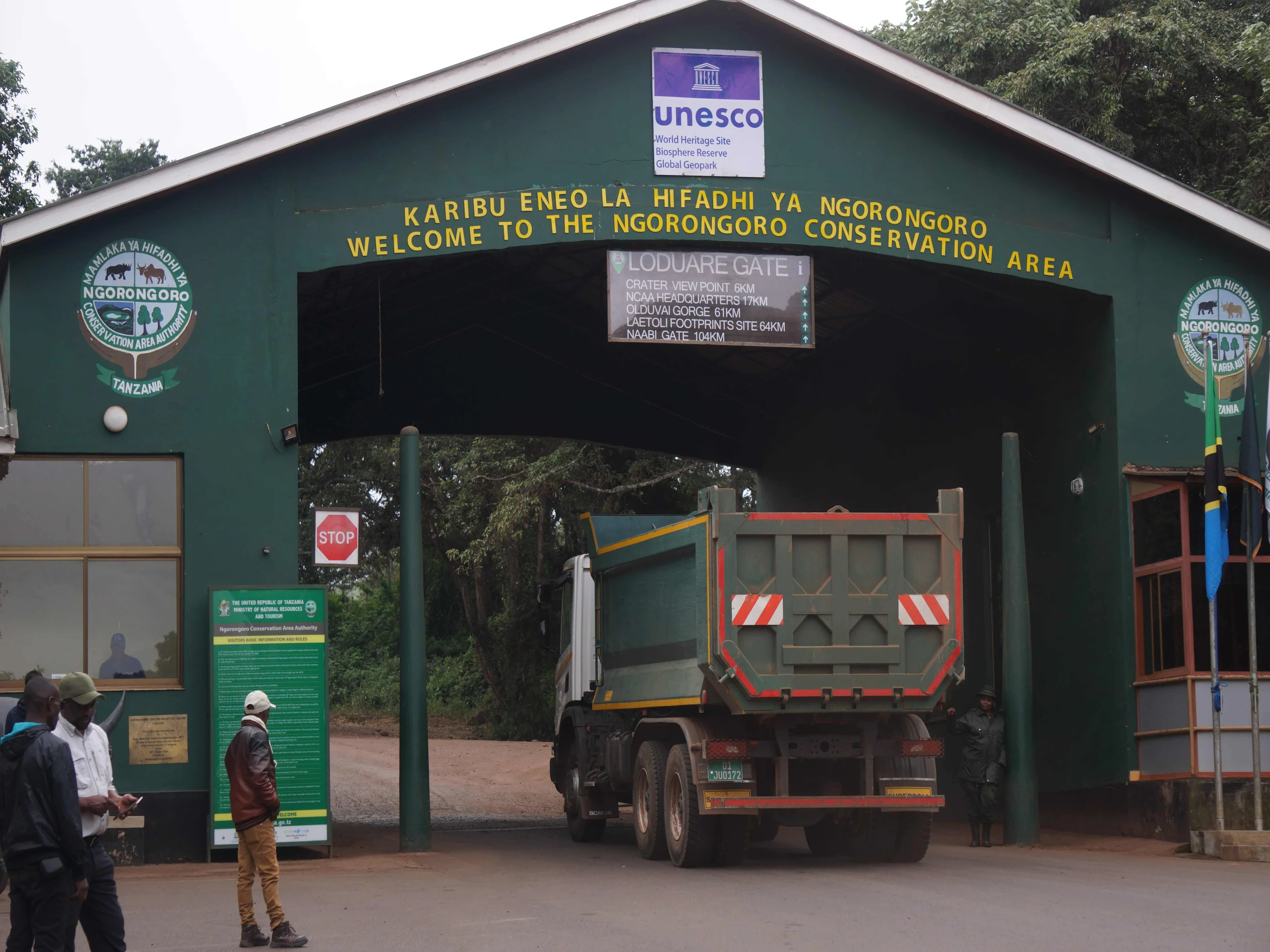
After reaching the Lodoare Gate of Ngorongoro National Park, we took a short break. Our guide took the permit for us and I visited the museum there. Do check this museum as it states a lot of facts about human evolution and the places it(Olduvai Gorge) began.
We got back in our jeep and within two minutes of entering the national park, our jeep broke down, such luck I have. But what was even more surprising was that every other jeep that passed us did make sure to stop and check if we needed any help. After being stranded for a little more than an hour, the jeep was fixed and we continued our safari.
Our first stop was the Crater viewpoint, which gives you a great view of the Ngorongoro crater. The Ngorongoro crater is the world’s largest caldera(a large volcanic crater). While it was still cloudy, this certainly was one of the highlights to begin the safari. On my fourth day, I would also be entering this and going for a safari inside the crater.
Within 10 minutes and we were still very much on the paved roads, we sighted the giraffe.
It was such an amazing sight because for the first time, I was viewing the wild animals roam freely and we were confined in a space.
We took some pictures and then moved ahead. I was just mesmerized by the landscape, and it was in so many senses very similar to what I had seen in the movie The Lion King. You would also see the famous Masaai tribes which live just outside the national park.
The paved roads had now turned into dusty gravel paths, and the unfortunate happened again. The car broke down the second time. At this point, I was unsure how we would finish the safari in this jeep. Our guide made a temporary fix and we resumed our journey.
Entering the Savannahs of Serengeti
Since the jeep had broken down multiple times, we had missed our game drive time on the first day. It was way past lunchtime and we were still not close to the lunch spot. We reached Naabi Hill which is the toll to enter the Serengeti National Park and our lunch spot by 3 pm.
Two good things happened here, first, we saw Simba. I mean a lion on the top of the hill, that was the best sight of the day after all the hassle. Second, there was a small garage that could fix our jeep.
While we had our lunch, our guide made sure the jeep was fixed so we could reach the camps and not get stranded on the way. At first, I thought it was just our jeep that broke down, but later I also saw a huge truck that was carrying at least 30 people who had some issues, imagine their situation.
After lunch, we still had two hours of game drive(safari). During this time we saw a lot of Thomson gazelles, an eagle, a vulture, and a few more giraffes.
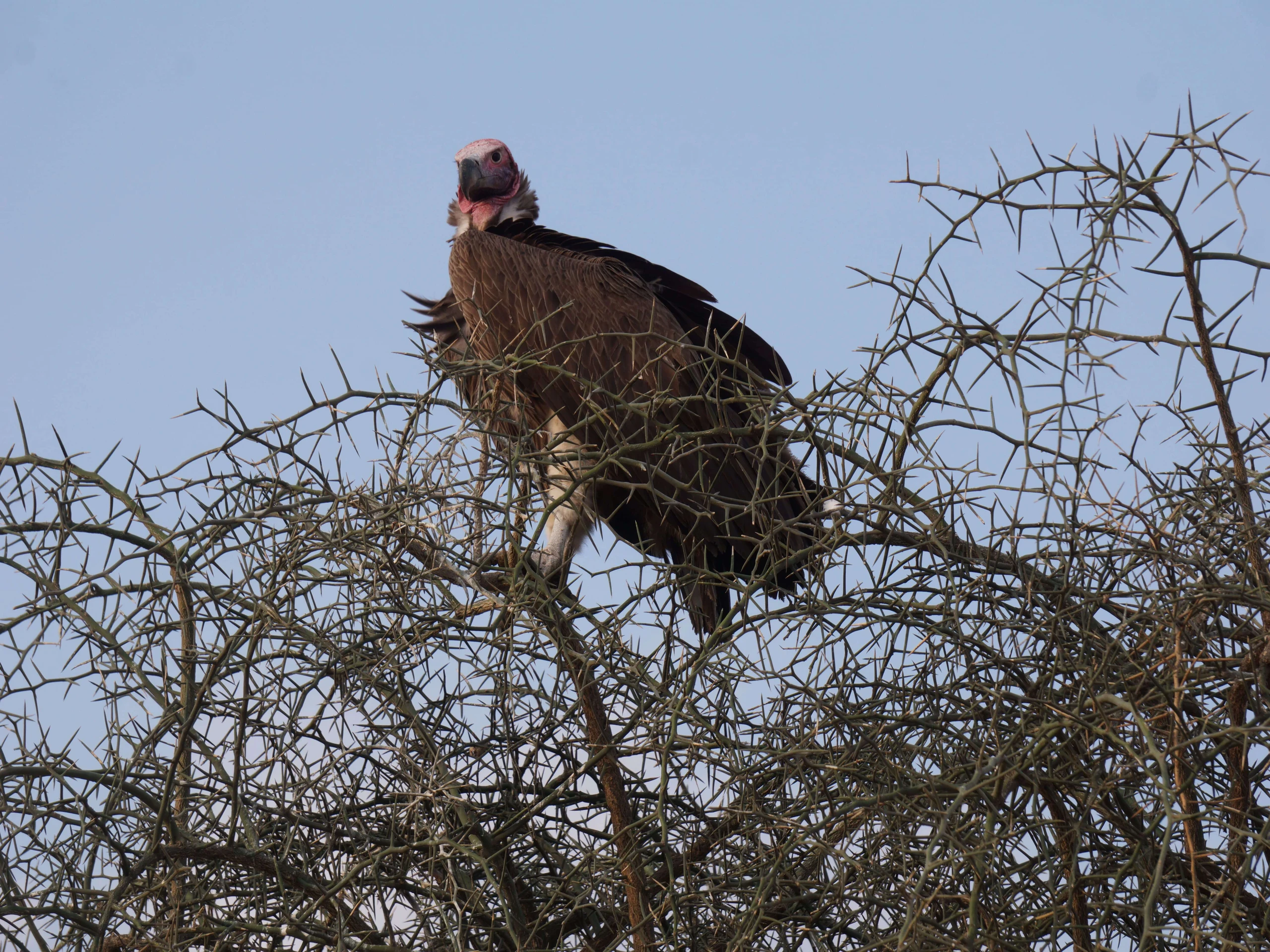
Witnessing the most beautiful sunset in Tanzania

We were nearing sunset and the end of the game drive, when we saw a hyena and two pumbas. Did you know the warthog is the animal name of what we know as Pumba? I didn’t know it until that moment and then my guide shared the information with me.
And then we saw a lioness, which was barely a few meters away from the jeep. We stopped and saw it for quite some time until it went away. And at the back, I could see one of the most beautiful sunsets I had ever seen. While I was watching the sunset unfold its beautiful colors, I realized that everything happens for a reason.
We reached our campsites and freshened up. Since there is very limited power at the campsite, I first put my gadgets for charging. This was a budget Tanzania safari and thus I was staying in camps, which to be honest was a great experience.
Every two jeeps have their chef, and since I was the only one from my jeep in this campsite I joined another group. While the others saw a lot more than me, I was still happy about the sunset.
After having the delicious lunch, I went to my camp early by 9 pm, and called it a day. The campsites barely have any network so you don’t spend much time on your devices.
Uncertain changes in the safari
The next morning I woke up with people trying to hurry up and get ready for their hot air balloon ride. I just stayed in my tent until the commotion stopped and then headed out to freshen up. Since it’s a shared campsite, there is a huge place for common washrooms both for men and women separately.
During the breakfast, I was joined by a stork who had just visited the campsite. After breakfast, we headed to pick up the other guests from another campsite. We had decided that for today we would be going to the northern Serengeti to see the migration. When we spoke to our guide, he said it wouldn’t be possible and he had to leave early and made all the possible reasons to not go.
This was such a big disappointment after the first day and I was very unsure if I would be able to see the migration. We started with our game drive around Central Serengeti and found quite a few lions and cubs in the starting but hadn’t seen them hunting.
We also visited the hippo pools and saw many wild buffaloes. Apart from the migration, I also wanted to see the Big 5 which consists of the lion, leopard, wild buffalo, elephant, and rhino. We have seen two of them so far the Lion and Wild Buffalo. We saw a lot of jeeps waiting in an area, our guide told us there was a leopard spotted. What a sight it was to see the leopard, but it was quite far to capture even with my 200mm lens.
Seeing the best elephant in Serengeti

Our guide and a few other jeeps decided to go to an area of central Serengeti where no one else was exploring. And it turned out to be the best decision. We saw a herd of elephants but didn’t understand the commotion. Later we saw a baby elephant that was just born and was on the driving path.
All the other elephants were protecting and covering it. At this time it was 3 jeeps present and everyone had switched off their engines. We spent a good 45 minutes watching the baby elephant trying to walk and the mother kept spraying the mud from around. This was a great experience and I was finally happy to see something this amazing.
Did you know that baby elephants take 20 minutes to stand up and can walk within 1 hour!
After this, we went for lunch to a lake overseeing the pink flamingoes. Had a great lunch and we were back on the drive.
Did you know flamingoes feed on blue-green algae which turns them pink in color!
Just after lunch as we were exiting that part of the Serengeti, our guide heard about another leopard in the vicinity. The leopard was just 20mts away on a tree and was the most beautiful sight. When the leopard looked towards us, I felt the fear that it could jump anytime.
Serengeti – the land Lions

We then moved from there and saw a small pride of lions, we stayed there for quite some time but you should know that lions are one of the laziest animals. Then moving a little ahead we saw a lone lion with its full-grown mane.
It was almost time for the end of the drive today when we saw a pride of 12-13 Lions together near the hippo pool. And they were just lazying around.
No wonder Serengeti is the best place around the world if you want to see lions.
After reaching the camp, the question again came up! When would I be going to see the migration? My guide informed me that I would be joining another Jeep for tomorrow.
There was another guide who was very helpful and was okay with me joining their group. I thanked him and stuck to what my guide had informed me.
The evening was very beautiful because it was also a full moon day. During the night, we could hear the roar of the lions, later in the morning the guide informed us that it was probably 2-3kms away from our campsite.
Unexpected events leading to the perfect safari
When I woke up and headed to the kitchen, I asked the chef and he said there would be other people joining me for breakfast.
And then I met my friend who I had first met when I was exploring Zanzibar. It so happens that I would be joining her jeep.
When I met Omary(guide) he said I would be continuing with him for the rest of the trip. For me, it was a little weird because that would mean I would be staying in Serengeti for the 4th day. We started from the camp, and the way Omary drove I was sure with no one other than him, I would be able to experience the Migration.
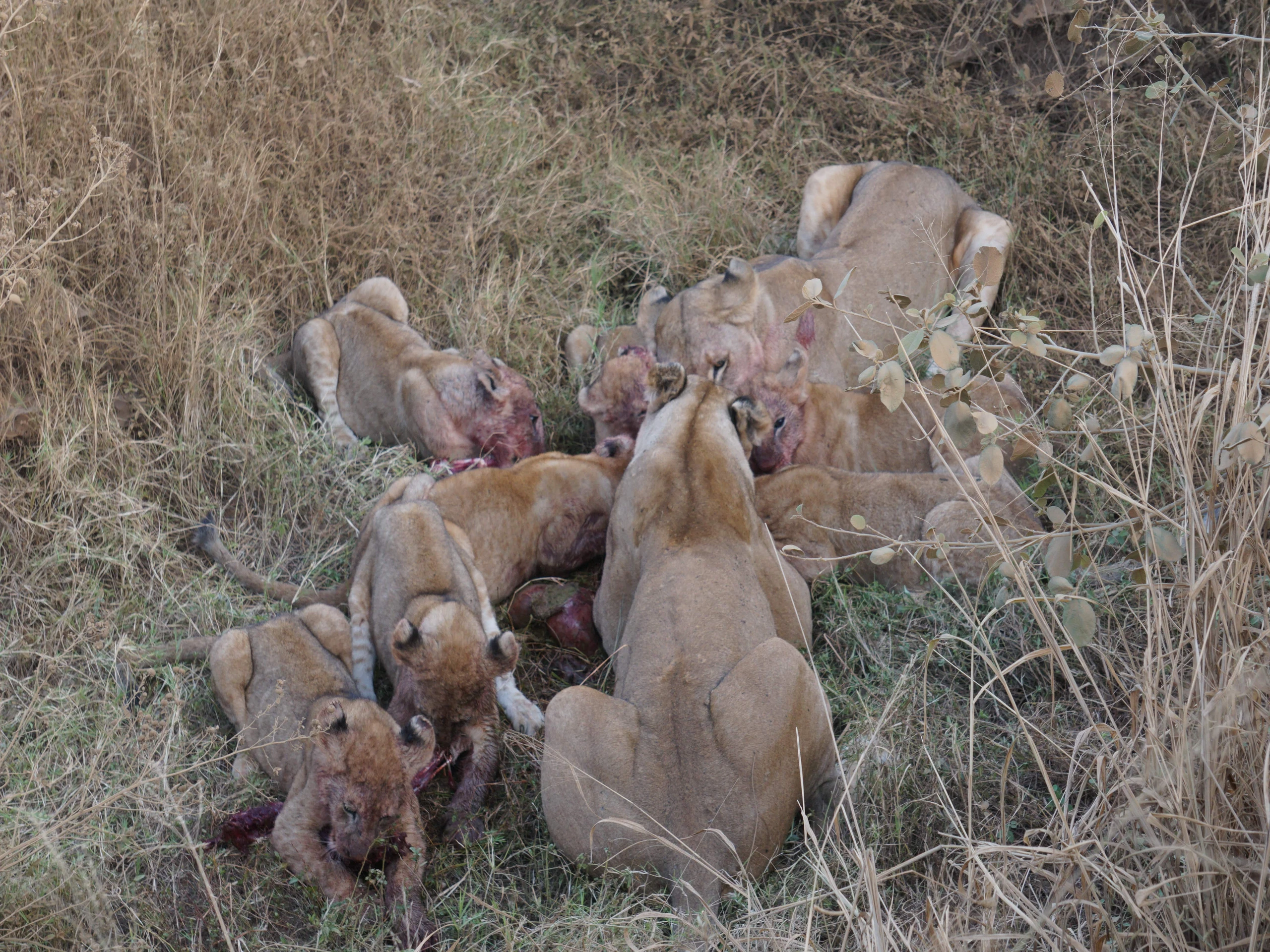
We were just 5 minutes into the drive and Omary heard on his radio, as soon as we reached that spot we could see a pride of lionesses and its cubs feasting on their breakfast. And we were right on top of them barely 5 metres away. The scene was so intense with blood on the cub’s faces. We were then on the way to the Northern Serengeti.
Onwards to experience the biggest wildebeest migration
Since the Serengeti National Park is so huge it takes a lot of time to reach the northern Serengeti where the Migration happens. It was going to take us approximately 4 hrs and with Omary’s driving I was thinking we would be there before time.
On the way, we saw a few hippos, Rafiki(Baboon), and a lot of elephants. We also saw a few lions which were by themselves and not a part of any pride. Also saw a lion and a lioness mating.
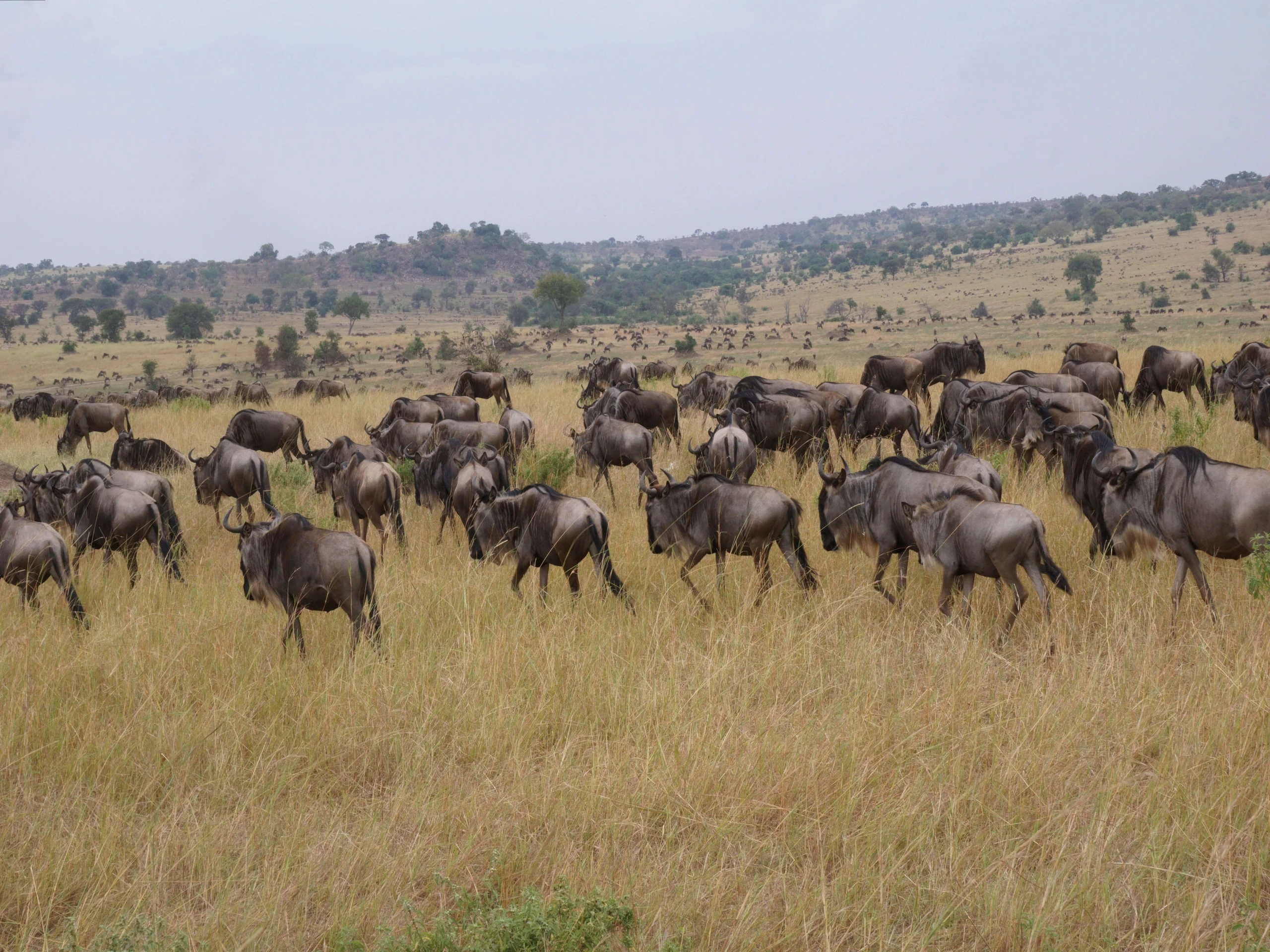
After almost 3 hours of driving, we were finally seeing a large(in thousands) number of wildebeest and zebras. This was the first time I saw the wildebeest in this park because the majority of them had already crossed the central Serengeti region.
I could already imagine my dream of seeing the wildebeest migration coming true. We were very close to the Mara River when we reached the Northern Serengeti Airstrip. If you’ve got no time you can also fly to this part and experience the Migration.
Did I witness the Greatest wildebeest Migration?
After taking the mandatory break at the Air Strip we then started towards the Mara River. Our guide told us there are multiple river crossing spots where one can see the migration or the iconic river crossing scene.
We first went to a river crossing spot where we saw a lot of Wildebeest just roaming and grazing around the river. After spending some time we went to the next spot and there were multiple jeeps at the spot! Thus we knew this was going to be the best spot to witness the river crossing.

It was finally time when the wildebeest had made up their mind to cross the river, though there were no crocodiles close by, it was the most amazing moment of this safari. The wildebeest hoping and trying to cross the river, I’m not going to forget that moment and that scene.
Wildebeest migration so different from what the show in documentaries
But the scene was so different from what they generally show on television and the documentaries. There was one more animal that at least I had not seen in the documentaries.
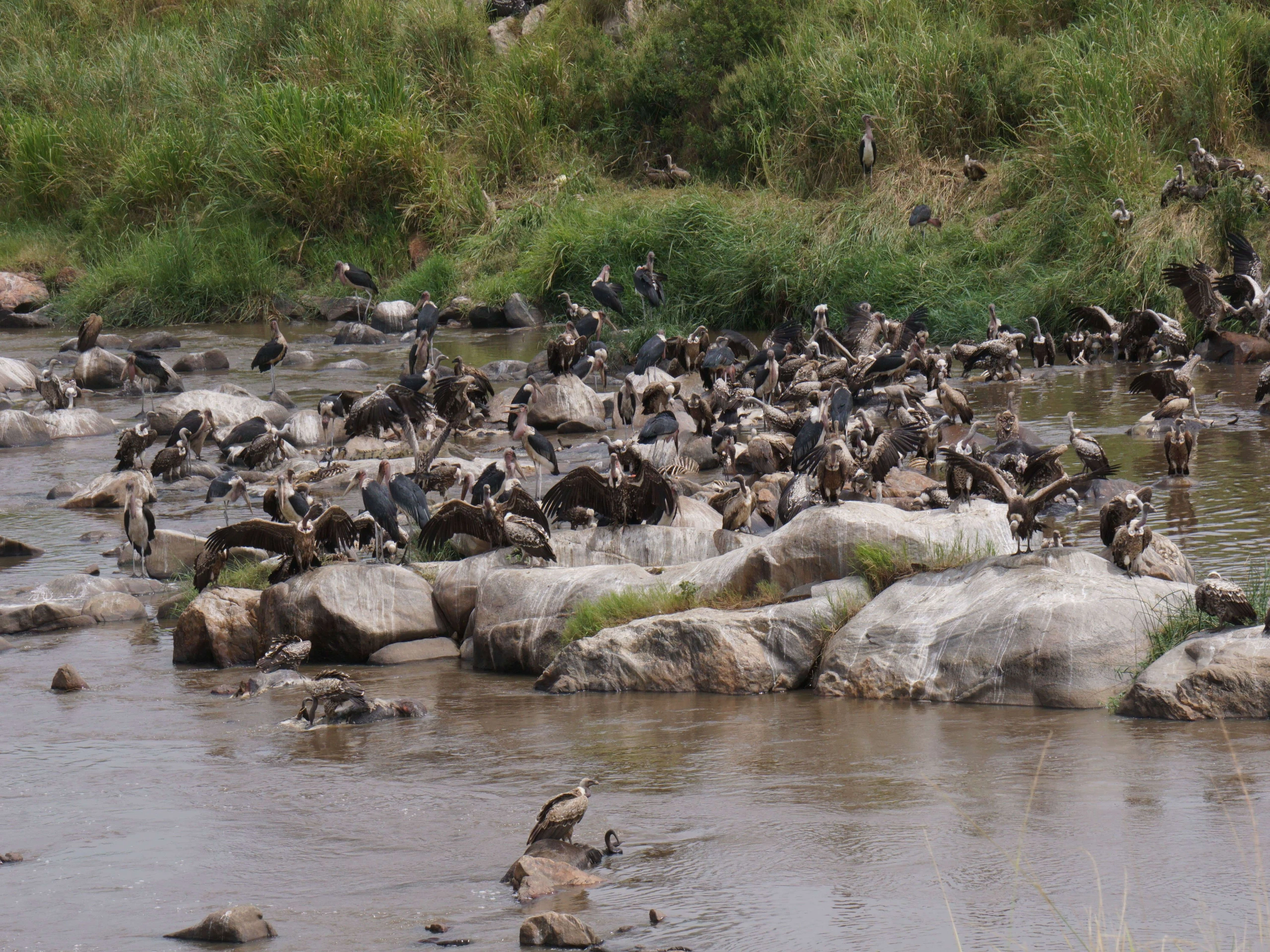
There were hundreds and hundreds of vultures closer to the river crossing area who were feasting on the dead wildebeest who either were killed by the crocodile or couldn’t cross the river and died by drowning.
After watching hundreds of wildebeest do the river crossing, we roamed around and saw the vultures and again came back to another spot where there were high chances of the crossing next.
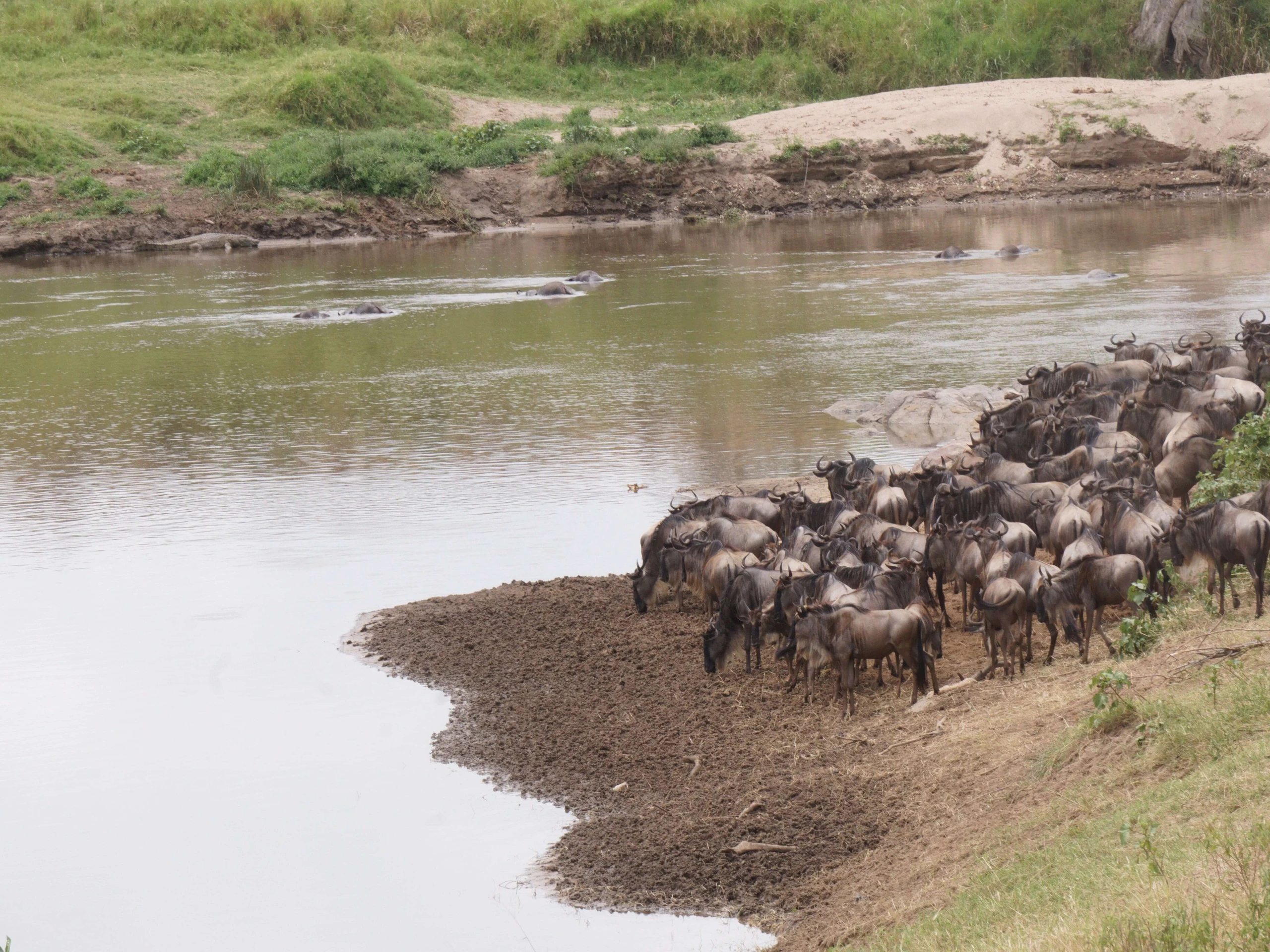
Wildebeest are also one of the dumbest animals and are always confused, so even though they reached closer to the river multiple times they didn’t do the crossing.
I was happy I at least got the chance to experience the biggest wildebeest migration and we had already spent 2-3 hours just following all the wildebeest.
The most interesting thing was having lunch very close to the river crossing spot, out in the open! Don’t worry, there are designated spots where you can get out of the jeep! It has to be the most scenic lunch I have ever had.
Expect the unexpected on your safari
After lunch, we again went back to the river crossing spot to see if the crossing was still happening but now we saw a crocodile very close to the wildebeest on the river bank because of this they decided to not do the river crossing.
We were then on our way back to the central Serengeti because it was going to be a long drive. On the way back everyone majorly took a nap after the tiring and eventful day. We were still 30 minutes away from our campsite when we got a flat tire and it was right next to the hippo camps.
Omary and another person who saw us helped exchange the flat tire, I too tried helping a little. But it was so scary because, at the same spot in the morning, there was a herd of elephants and a group of baboons.
After reaching the camp and freshening up, we just had our dinner and went early to our camps.
4th Day in the Serengeti

Another day in Serengeti and I had almost seen everything(rhino was still pending from the Big 5). Since we had only a half-day game drive we left our camps a little late and just tried spotting some of the prominent Big 5’s.
We tried looking for leopards but missed the chance by just a few minutes as they hid behind a rock.
We saw quite a few lions and then went to see the other cats. Almost 30 jeeps were trying to spot the family of cheetahs. They were quite inside from the path and hidden behind the trees. Since we had majorly seen everything we waited for quite some time near the cheetahs.
To our luck, the mother did try to go for a hunt but was unsuccessful. After which were were on our way to Ngorongoro Camp site. On the way, we were lucky to spot a leopard up close who was just lazying around on the tree top.
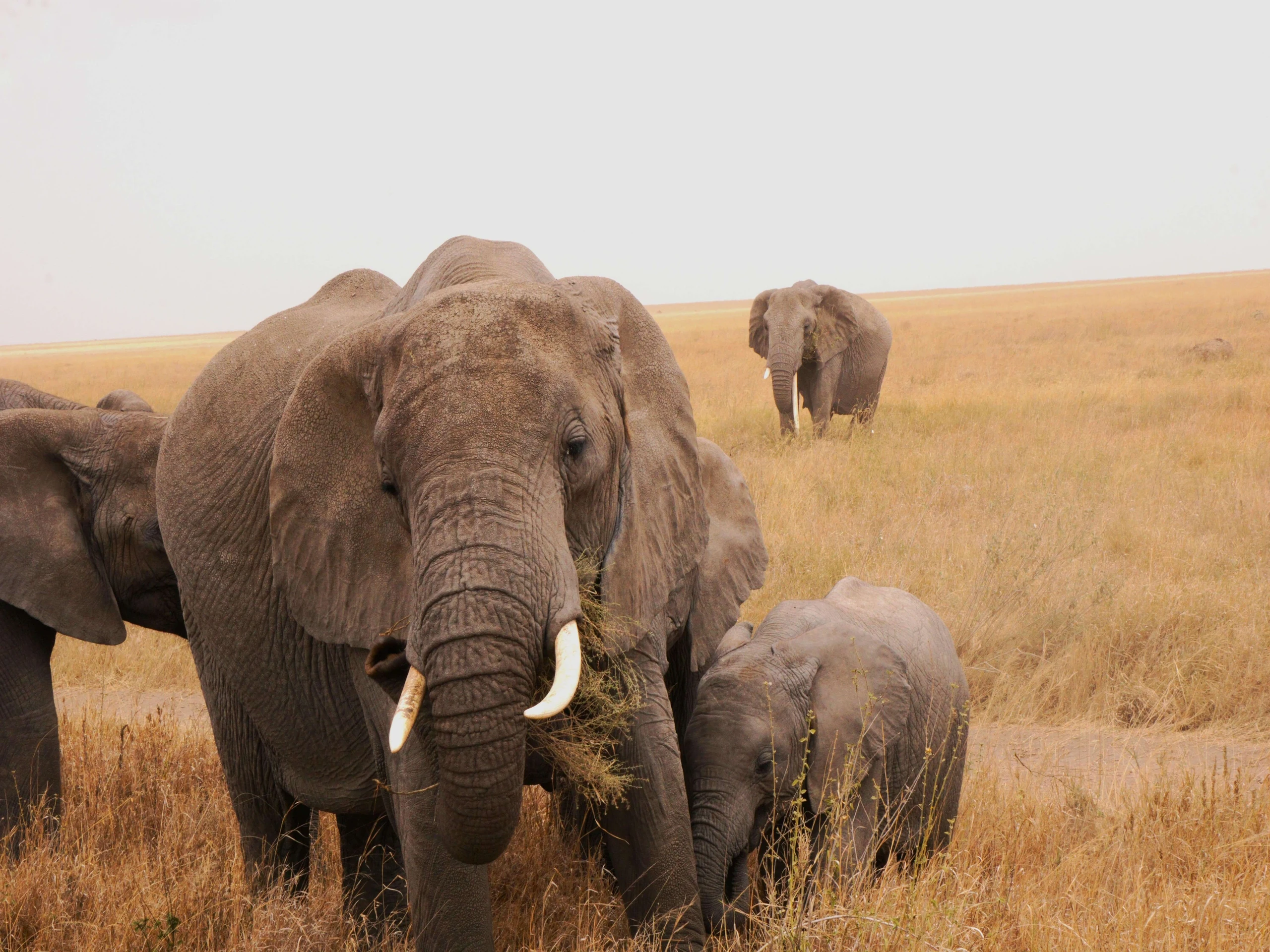
A little while later, we were covered with a herd of 15-20 elephants who were crossing the path. This was both magical and scary at the same time.
Exiting Serengeti and reaching Ngorongoro Campsite
We had our final lunch in Serengeti near the same Simba Hill where I spotted my first lion.
We were not able to see the rhinos in Serengeti and the reason for that was also because they are very low in number because of poaching and like quieter places.
On the way, we also picked up travelers from another jeep because their jeep broke down.
After reaching the Ngorongoro campsite, the chills started to hit this was the only campsite that had hot water, or was so told by my friend. But when I was in the shower there was barely any warm water. Having a cold shower in a cold temp, I had to later wear 3-4 layers because of the wind and the cold.
After our dinner, we came out to see the zebras at the campsite. When we got in the tents as well we could hear them grazing and also walking very close to the tents. The night went by pretty quickly battling the cold, it’s better to carry layers at least for the Ngorongoro campsite.
Day 5 Entering one of the seven natural wonders of Africa
It was my final day of safari and we had an amazing breakfast since this was our last meeting with the chef we bid him goodbye. The food and the varieties he served were so nice.
We were then on our last game drive entering the Ngorongoro Crater. There is a paved path that leads you inside the crater. I was earlier thinking I had seen almost everything that would be different in the crater. But I was so wrong, the landscape was so different and since the crater is small(when compared to Serengeti) you can spot so many different animals in one spot.
We spotted the impala, Thomson gazelles, zebra, wildebeest, hippos, hyenas, and flamingoes within just one hour of the game drive.
Landscape of Ngorongoro Crater
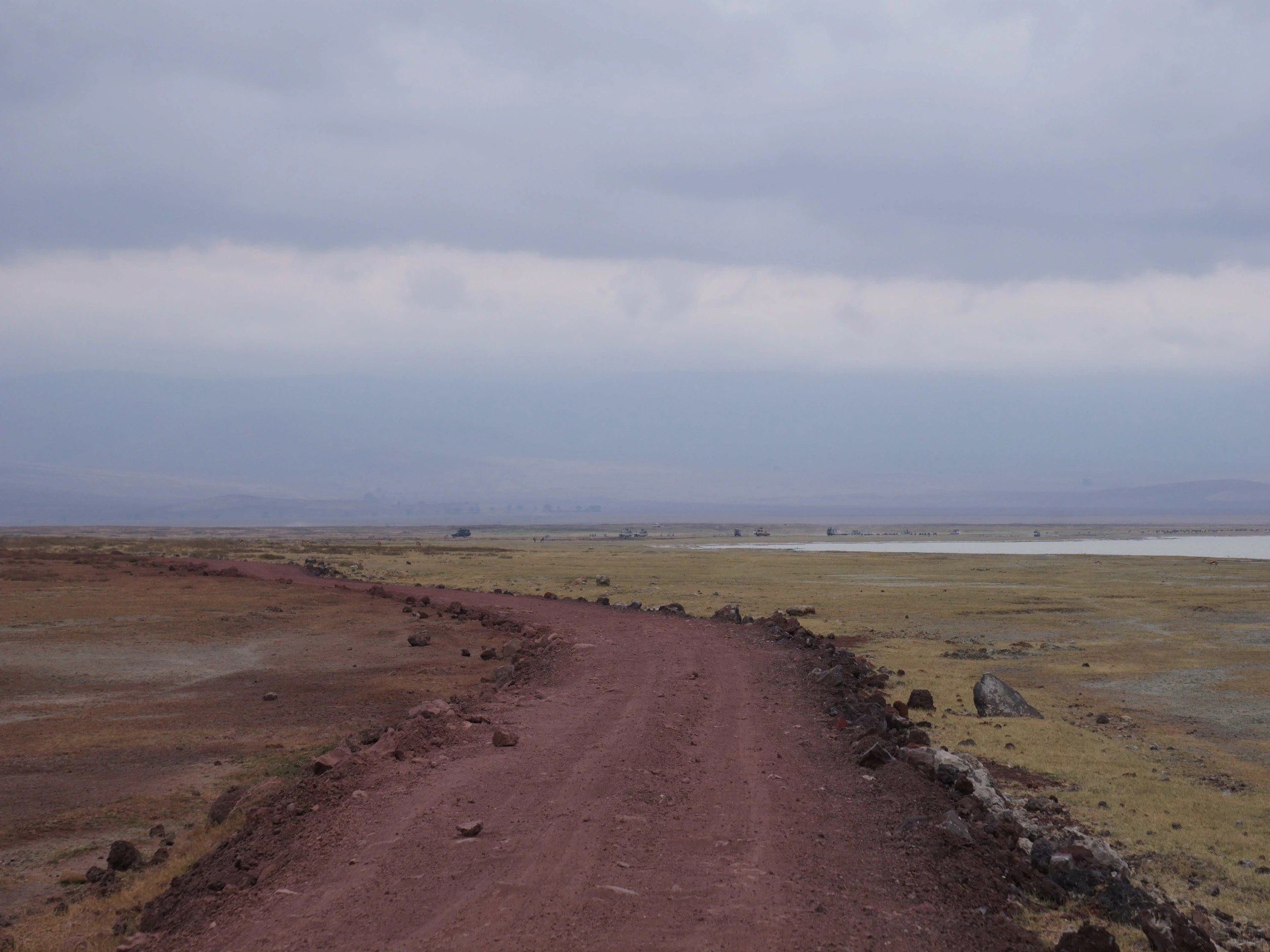
The landscape varied so much on one side of the path it was all green and on the other, it was just brown.
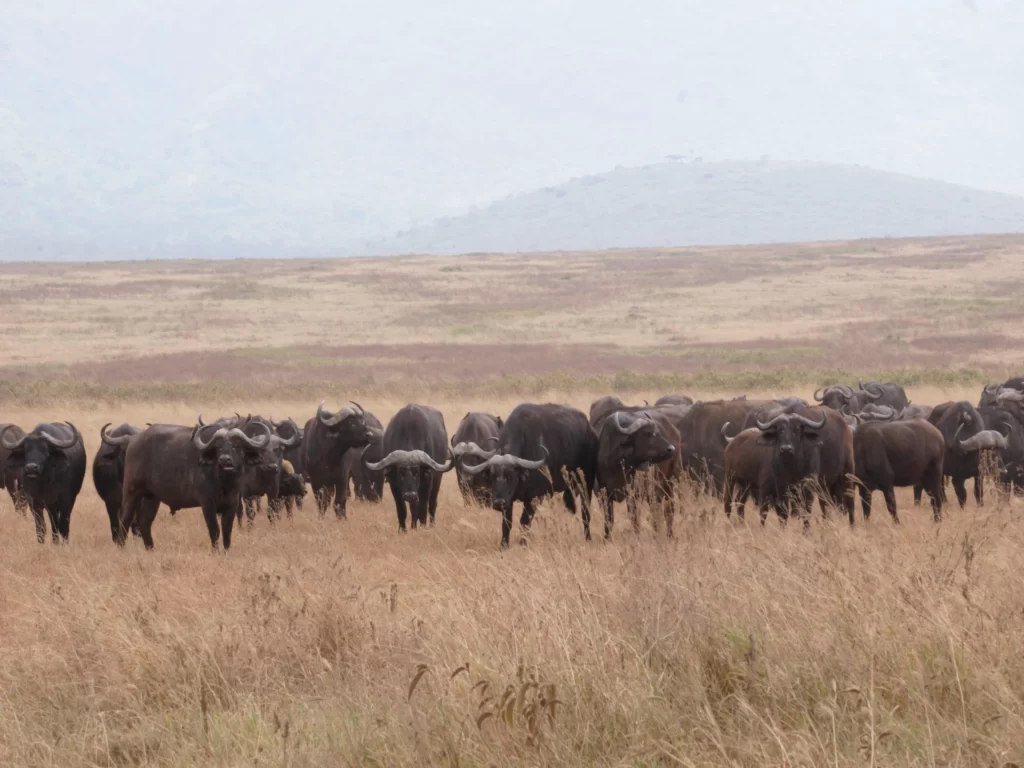
We then saw a wild buffalo who was walking towards the pride of lions. Luckily the buffalo was able to run away but what an amazing scene it would have been.
The Ngorongoro crater was our best bet to see the last Big 5 – rhino, because of the smaller area. After spotting a few pride of lions we were at the picnic spot, where we saw a few people taking a walking safari inside the crater.
We had the second most scenic lunch spot inside the crater by the lake. When exiting the crater we thought we could spot the rhino, but it was not in our luck. But I was still happy because I had experienced what I had come here for.
I was also visiting Kenya to experience the Migration from the other side of the Mara river.
We then exited the conservation and headed back to Arusha.
Ending the Safari on a happy note

I was grateful that I found Omary later because of whom I was able to experience the Greatest Wildebeest Migration.
So that is how this 5-day migration safari, which had 3 days in Serengeti and 1 day each in Ngorongoro Crater and Tarangire National Park turned into 4 days in Serengeti and the last day in Ngorongoro Crater.
While I was not able to visit Tarangire, I would suggest you add it to your safari! I was lucky because I was going to the Elephant’s backyard in Amboseli National Park in Kenya after this.
Which operator did I do the safari with?
I did this 5-day Budget migration safari with Raymond from Serengeti Landmark Tours. Though there were a lot of hiccups during the safari I was thankful to Raymond for being able to show me the Migration with no added cost.
Contact Name: Raymond
Contact number: +255 629 484 291
While the main company that was handling the on-ground experience was Omary from Travel Africa Safari Agency, I don’t think this safari would have been so good without Omary as the guide.
Contact Name: Omary(Guide)
Contact Number: +255 784 533 237
I would recommend both Omary and Serengeti Landmark tours for your safari experience in Tanzania.
How much does the wildebeest migration safari cost
The safari cost is very subjective to the type of accommodation, safari length, and the tour operator. A budget migration safari in Tanzania will cost somewhere between $200 – $300 per day.
For camping, you might be able to find the safari for approximately $200/day and if you want to stay in the comfortable lodges you might be able to find packages at $300/day onwards.
FAQ about Tanzania safari
Q1. What is the 5-day Tanzania Camping Safari?
Ans. The Tanzania 5-Day Camping Safari generally includes 2 nights staying in a camp in Serengeti and one night in Ngorongoro Crater. The first day is usually in a lodge near Tarangire National Park. This is the cheapest way of experiencing the migration safari.
Q2. What are the big 5 on a safari in Tanzania?
Ans. The big 5 include the lion, leopard, wild buffalo, elephant, and rhino. They were considered Big 5 because of the difficulty in hunting them
Q3. Why are Tanzania safaris so expensive?
Ans. Tanzania safaris are more expensive than Kenya because of the higher park fees. This includes maintaining the national park, wildlife reserves, and anti-poaching efforts.
Q4. Is Kenya or Tanzania better for safari?
Ans. In my opinion, after experiencing budget safaris in both countries I found the Tanzania safaris to be a lot better in terms of the service and the visibility of the animals.
Q5. How long should I stay in Serengeti?
Ans. If you want to experience the wildebeest migration it is best to stay in Serengeti for at least 4 days. And if you want to experience the best chances of seeing the Migration it is better to stay for 2 days in Northern Serengeti.
Q6. What is the best month to visit the Serengeti?
Ans. It’s best to visit the Serengeti from June to October as that’s the best season to experience the Migration. Another alternative is to visit Serengeti during December and January.
Q7. Is the Tanzania safari worth it?
Ans. So far I’ve just done two safaris in Kenya and Tanzania and I would say the Tanzania safari is worth all the price you pay.
Q8. Is the wildebeest migration worth it?
Ans. According to me, there couldn’t be another natural phenomenon that tops the Great Wildebeest Migration. When you see millions of wildebeest and Zebras trying to cross the Mara river it does make of an amazing scene.
Q9. How long does the great migration last?
Ans. The Great wildebeest migration starts in June and lasts until October. But even during that duration, it is best to visit Serengeti between mid-July and mid-August.
Want to relax after the safari in Zanzibar’s pristine white sand beaches or gear up for another adventure in Tanzania? Read the blogs below
- Zanzibar travel guide for first-time visitors
- Ultimate travel guide to Paje
- Zanzibar’s hidden gem: Kizimkazi
- 14 Must-try local dishes in Zanzibar
- Guide to Climbing Ol Doinyo Lengai: Tanzania’s Active Volcano
Have any more questions about the safari or need some help planning it? Drop down your queries in the comments or message me directly on my Instagram: Stories.of.raku





